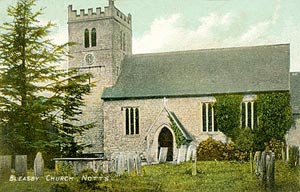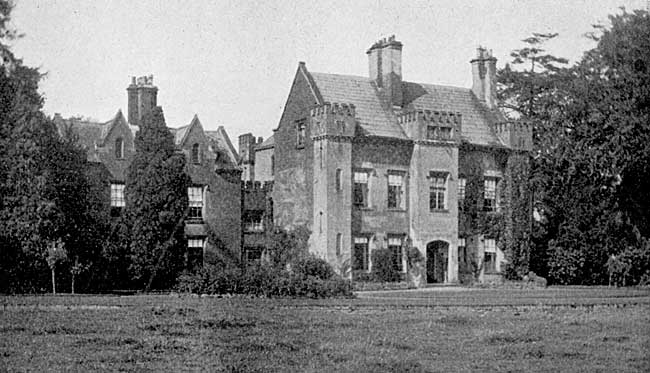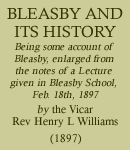THE CHURCH.

Bleasby church, c.1910.
Bleasby Church is dedicated to S. Mary, and the feast is kept at the Nativity of the Blessed Virgin (S. Mary's Day in Harvest)—old style. It is well to remember that most of these village feasts record the people's thankfulness that they have a parish church, which fact is sometimes forgotten in their secular rejoicing. Bleasby feast is not kept now on any large scale, but it is still a "mothering Sunday," the distant members of a family gathering round the home fireside. The architecture of the church shows traces of some very ancient work, but it may be described as a modest village church, neat, comfortable, and well kept, rather than as possessing any particularly grand or imposing features. It originally consisted of a chancel, nave (without aisles), and west tower, and was in nice proportion, but it has been a good deal knocked about and altered in various restorations.
Before the restoration of 1816 the chancel was roofed with tiles, the nave which had two courses of windows (a rather unusual feature when there is no aisle), was covered with lead, and a healthy elderberry bush grew out of the top of the tower. At a restoration at that time (1816) the windows of the clerestory course were brought down and united with those below, and a new roof of timber and slate put on the nave and tower. At the same time the floor was re-laid, and new pews (I suspect of a mean character) put in. At that time the flat stone which had covered the two Vicars—the inscription of which was so worn away that it was probably unnoticed— must have been taken up from the aisle or chancel and placed in the church yard, eastward of the chancel. We hope to take steps to have the inscription and epitaph placed where it can be read in the church.
In 1853, Mr. E. K. Kelham added the battlements to the tower, and afterwards gave a font of the perpendicular style, copied, I believe, from that at S. Ebb's, Oxford: and two stained memorial windows in the chancel and tower were given by the same family. When Mr. Marsh came he found the church in poor repair, with poor seating, and with a large west gallery, where the musicians of the band (one of whom is still living) had their place. Enlargement and repair were found necessary. The chancel was entirely re-built by the Ecclesiastical Commissioners, smaller than before, and badly lighted, and the symmetry of the church was destroyed by a broad lean-to aisle and semi-transept on the north side, and we have now a building warm and weather-tight, if not very beautiful in its proportions.
Whilst on the subject of the church, I may mention that the period of the supremacy of the Parish Clerk was ushered in and signalised by an entry in the registers, "Maye 4, 1729, William Walch comes in for Parish Clerk, Mr. Fowler Viccer"; and the registers, which till then appear to have been kept by the Vicars, assume for the time some curious varieties of writing and spelling. Three generations of clerks of the name of John Corden occupied that honourable post for more than a century—
John Corden the first, 1777 to 1790.
John Corden the second, 1790 to 1832.
John Corden the third, 1832 to 1881.
The office was shorn of a considerable portion of its dignity everywhere by the abolition of Church Rates. During the later period of the reign of John Cordon III. William Mountney was deputy, and succeeded him in the duties till he resigned in 1889.
A new altar in the place of one which was most decrepid, patched, and worm-eaten, was placed in the Church in 1893. It was made by the village wheel-wright from an oak tree grown in the parish, and its front panels are enriched by paintings, the work of a parishioner. A second bell was purchased in 1810, and placed in the tower. The tower is surmounted by a weathercock, which has been a bird of rather ill omen. It formerly belonged to S. Peter's, Thurgarton, but descending one stormy night upon the roof of the Church and committing considerable havoc, the authorities of Thurgarton were not willing to replace it and risk having their rest disturbed again, and ultimately gave it to Bleasby. It has once jumped down upon us at Bleasby, but we have put it up again more strongly, and given it one more trial.
In the Churchyard there is a fine recumbent stone cross from Pugin's design in memory of the late Mr. R. K. Kelham: and a stone recording the death of a child with the following inscription:—
Here lies a flower cropped in the bud by Death,
And now shee's mouldering in the silent earth;
Good mora's did her dearest actions guide.
She lived beloved, and much lamented died
In the 2nd year of her age.
This is a great testimony to the effect of education in Bleasby on the very young.
Bleasby has only one Parochial Charity, arising from land at Fiskerton, left by Ann Crossland, producing £1 in the year, to be bestowed on the poor of Bleasby, by the hands of the Churchwardens and Overseers, upon the day of St. John Evangelist in Christmas every year.

Bleasby Hall, c.1901.
Bleasby Hall was always a residence of some importance. After the Stathams, who were, as has already been mentioned, living there in 1502, when the quarrel with the Vicar took place—the family of the Grundys came about 1600. Mr. John Grundy was married to Mrs. Elizabeth Shierbrook, of Oxton, in 1661, and several marriages of the Sherbrook family took place at Bleasby in subsequent years. Another Mr. John Grundy, the last male resident at the Hall of this name, was High Sheriff of Nottinghamshire, in 1722, and died the same year. His widow lived at the Hall till 1735. when her daughter married Mr. Beetson (or Beeston), and the family removed to London. Mr. Nathaniel Need and Mr. E. S. Falkner were in turn the subsequent owners of the Hall till it was purchased by Mr. R. K. Kelham in 1816. His son, Mr. Robert Kelham, a Justice of the Peace for the County, is now resident and filled the office of High Sheriff in 1874. The present squire has given to the parish its church clock and brass eagle lectern, and is always ready in his support to parish institutions.
The first public step in the direction of the education of youth (besides the usual dames' school) was the erection of a whipping post in 1763, at a cost of 2s. 6d., which we hope had a salutary influence on the morals of the neighbourhood. Stocks already adorned the village, and have been in use during the memory of present inhabitants.
A Sunday school was commenced in 1822, and has continued ever since.
The Elementary Day school was erected in 1855, and is well supported and efficient.
The old "Town Book," containing the accounts of the constables, overseers, and churchwardens from 1747 to 1777, is kept in the parish chest, and shows many curious entries of relief of the resident poor, "strangers with a passe," &c. The maintenance of the poor being then chargeable on the parish where they had settlement, several cottages called "the poor houses" were built here at the expense of the parish on vacant space by the road side in Notown, and let at small rent. These were ultimately seized upon by the agent of Sir Richard Sutton, because they encroached on his frontage, and rather than incur the expense of a law suit the parish surrendered them.
They, however, successfully contested two suits with neighbouring parishes, by which they succeeded in justly saddling them with the responsibility of the maintenance of two paupers.
It may be doubted whether the old method of apprenticing a poor child to some farmer to clothe and feed and teach labouring work till he was 21 years of age was not, perhaps, a more sensible method than the system which followed—of herding the children together in the workhouse.
Mr. John Holmes relates the great rejoicings held in the village at the conclusion of the European Peace in 1814 (when Napoleon was shut up in Elba), after so many years of war. Peace! alas, so soon to be broken, and followed by his escape and the great Waterloo Campaign.
Reminded by the earthquake which was felt here this year, I may say that he also records, "On Sunday, March 17th, 1816, the village and the surrounding country for many miles was thrown into the greatest conternation about half-past 12 o'clock by a serious shock of earthquake. Divine Service not being over at the Parish Church, the congregation (and myself) distinctly felt the undulation in the motion given to the building for about three or four seconds. It being Assize Sunday at Nottingham, the Judge and his retinue being at St. Mary's Church, it was perceived to shake very much." Mr. Holmes also records the floods, but as one flood is very like another, we do not insert the particulars. The village also had a Cricket Club in 1818.
The price of wheat in 1812 was 122s. a quarter. I have been informed that during the Crimean War one field in this village yielded nine quarters to the acre, which was sold at 90s. the quarter—a condition of things which would be very refreshing to the farmer of the present day, if not to the people. This parish has always been agricultural in its character (though there were a few frame-knitters); and it is well thought of for its soft cheese. The character of the place has considerably altered since the railway was made; year by year more of the inhabitants going to Nottingham to business, and the charms of Hazleford Ferry having made it a great place of holiday resort.
The population was 275 in 1815, and rose to 370 in 1848, and now stands, both at the 1881 and 1891 census, at 282.
I notice that the tendency is to alter the houses to suit people who have business in the towns, rather than to build good labourers' cottages. There is no inducement to the landowners to build good labourers' cottages, as they do not pay, and it is becoming a matter of difficulty to house the labourers. The Ecclesiastical Commissioners have, however, set a good example by building two excellent cottages, but more are really wanted.
The following surnames known in the neighbourhood are found in Bleasby Register:—Horspool, Branston, Baguley, Harrope, Harvey; and of Christian names, quaint and old, for boys, Malevora, Originall, Gervas; for girls, Benit, Arbella, Sicily, Dynas.
A constable's rate was collected here till 1891, and moles and sparrows destroyed. This has now been allowed to lapse.
No account of Bleasby would be complete without some mention of the famous Fox Cover—Bleasby Gorse—which in the view of some people is the justification of the existence of the place. Shortly after the Railway was made a new cover was established on Goverton Hill which still maintains its old reputation. The Hazleford Ferry Steeplechase Course, in connection with Lord Harrington's Hounds brings large crowds into the village. There is (I consider) a strong feeling of love to their parish amongst the inhabitants of the village, and a disposition to consider this one of the pleasantest spots in the country. The lanes and hedges are well kept, and in their season violets abound. We did not take advantage of the late Act to form a Parish Council, but are satisfied with the simpler and more democratic "Parish meeting"—and this important body is economically disposed and has hitherto carried on the work of the parish without calling upon the ratepayers to incur a single farthing of expense.
